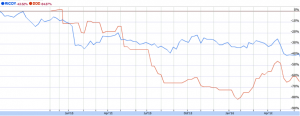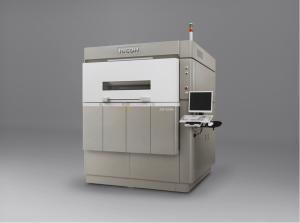Ricoh shareholders arriving at Friday’s AGM within Tokyo’s labyrinth like Shinagawa Prince Hotel may have experienced déjà vu on hearing the company’s plans. Facing what CEO Zenji Miura calls a “watershed” year, this recent entrant into the 3D printing market will invest more than $2 billion in finding a new direction. Will this strategy be successful, or will it lead to further confusion about the direction of the business?
Ricoh are a multinational company operating in over 200 countries and employ 109,361 people worldwide with 35,700 based in Japan, where the company was founded in 1936. The business has multiple revenue streams from office imaging, production printing, network system solutions, industrial products and more recently 3D printing.
While recording profits that would be the envy of most pure-play 3D printing businesses, Ricoh failed to meet forecasts for the second consecutive year.
Profit continues to fall
In their most recent financial accounts, Ricoh reported a 12% decrease in profit, from $1.03 billion to $909 million*. This downward trend is a continuation of the previous year. However, the pace has increased with a 12% fall in profit for 2016 compared to a 4% fall between 2014 and 2015.
Earthquakes in Japan’s Kumamoto Prefecture damaged several Ricoh buildings and also affected logistics during the year. However the main cause identified for the company’s declining performance was the general business climate. Earnings decreased because of intensified competition and the need to offer measures such as discounts to attract sales.
Movements in the JPY:USD and JPY:EUR exchange rates acted against the global company and forecast sales in the Americas and Asia did not match reality.
Affiliates have also created problems for the company. Ricoh India notified the Bombay Stock Exchange of progress on an ongoing investigation into failure to file financial results on April 20th, 2016. As details of an alleged fraud at Ricoh India Ltd began to emerge in May the parent company’s share price fell off a cliff dropping by 25% from $10.74 on April 22nd to just above $8 for ADR’s.

The company anticipates continued declining sales during 2017. While Ricoh increased sales volume in its core imaging and solutions division, actual earnings for this group were down. Furthermore, with the ubiquitous nature of smartphones the digital SLR camera market has “stagnated”. A view supported by Canon and Nikon who are major players in this market.
Against such a background it is understandable why Ricoh want to identify new products and services. This has brought them to several new fields, healthcare, an environment focused business and 3D printing. At first glance, a disparate array of industries.
Entry into 3D Printing
In 2014, when Ricoh announced their intention to enter the 3D printing market, investor optimism was near its peak. At the beginning of that year several major 3D printing companies were valued in sums reaching billions, primarily driven by expectation rather than booked profits.

Diversification is undoubtedly necessary as competition in core markets intensifies. However, with projects in brain-imaging, solar power and automated external defibrillators the approach could give the impression of panic rather than strategic. A scattergun approach to acquisitions will not be the first time a 3D printing company has been hamstrung by an unfocused approach.
The financial results were not entirely negative. Ricoh have become a market leader with their proprietary ultraviolet ink for inkjet printing. Also, their inkjet heads have, “top shares of the global industrial and 3D printing markets”. As previously reported, these products use laminated piezoelectric technology. In their OEM guise, Ricoh has made components for a number of 3D printer manufacturers including Objet.
Income from 3D printing activity is reported within the “other” section of Ricoh’s financial statements. For 2016, total sales within this category were 5% of overall sales, this figure is forecast to increase to 5.4% for 2017. In the short-term Ricoh is not pinning hope on 3D printing. However they have previously announced their 3D printing business will contribute $2.8 billion in annual sales. This is more than double the amount currently reported in this category.
To date, information on sales of the RICOH AM S5500P is sparse and when approached by 3D Printing Industry Ricoh’s Corporate Communication Center declined an opportunity to provide comment. In contrast to HP’s MJF open approach to materials Ricoh have previously stated they will develop proprietary materials with the Japanese company who were partners in the AM S5500P project, Aspect, Inc.
Ricoh concluded its latest reporting period with a larger cash and cash equivalents balance than the previous year. However, this increase was not a result of cash flow from operating activities, which declined, but due to a decrease in investing activities (such as research and development) and also an increase in cash flow from financing.
Intellectual Property Portfolio
Intellectual property is worthy of a mention at this point. The AM S5500P is an industrial selective laser-sintering (SLS) machine. This technology was developed by Carl Deckard and Joe Beaman and then patented in the 1980s. While the early IP around SLS expired in 2014, the specific term “SLS” is a registered trademark of 3D Systems who acquired the IP in 2001.
Ricoh developed their industrial 3D printer in partnership with another Japanese company, Aspect Inc. Aspect’s president & CEO Seiji Hayano’s, “involvement with AM goes back to 1986, when I first learned about Stereolithography while working for Mitsubishi Corporation.” In 2008, Aspect demonstrated their SLS machine. The SEMplice featured a 16-watt CO2 laser with a scan speed of 5 m/s and a beam width of 0.275mm, it was shown at Japan’s Design Engineering & Manufacturing Solutions Expo (DMS). Hayano also developed the RaFaEl, a powder bed fusion machine.

However, the patents filed by Hayano appear to relate to stereolithography processes, rather than SLS. Although Ricoh does have a sizeable IP portfolio, further clarity on how much relates to 3D printing would be useful in assessing any competitive advantage in this area.
A golden age of 3D printing?
Ricoh is forecasting a 25% decrease in profit for the current year. Despite this the company plan to increase R&D expenditure by almost $95 million and will also increase capital expenditure by approximately $55 million. The total 2017 forecast for R&D and capital expenditure is more than $2 billion.
With sales in Japan dropping in each of the past 5 years, Ricoh is keen to develop new geographic markets. Of these markets the Americas region has had the most success, although revenue does not yet match that generated in Japan where the company is still strongest.
Increased participation in 3D printing by multinational companies with revenues in the billions marks an important milestone for the industry as a whole. A point Shapeways co-founder and CEO Peter Weijmarshausen observed during a panel at this year’s SXSW conference.
With sizeable R&D budgets, access to expertise and diversified revenue streams large enterprises have a capacity to produce machines that in the hands of innovative users will create wonders. Conversely, market forces and commercial pressures do not guarantee consumers the “best” technology as the Betamax vs. VHS video format clash demonstrates.
Ricoh may currently be down, but it would be a mistake to think this giant is out.
The full presentation of financial results is available here. (PDF)
*Ricoh report financial results in Japanese Yen. These values have been converted to U.S. Dollars using the interbank exchange rate as at the financial reporting date, 31st March 2016.


